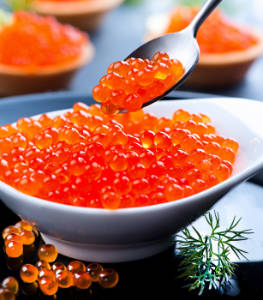Fish Category

Cooks often divide fish into two categories, fatty (or oily or rich) and lean. These two categories can be split again, by whether their texture is firm or flaky.
Fatty, firm fish include tuna, eels, catfish, shark, and swordfish.
Fatty, flaky fish include salmon, herring, mackerel, and sardines.
Lean, firm fish include grouper, lingcod, mahi-mahi, and striped bass.
Lean, flaky fish include cod, flatfish, and rockfish.
Shellfish aren't technically fish, but they're usually sold at the fish counter, so we've lumped them into this category.
See also: Smoked or dried fish.
shrimp
There are many different species of shrimp, but generally speaking, the larger the shrimp, the tastier. In the US and Britain, large shrimp are called prawns; in India, all shrimp are prawns. Bay shrimp are very small. You can buy shrimp raw (sometimes called green), or cooked. Don't buy cooked shrimp if you plan to serve it warm--they turns rubbery when reheated. Unopened canned shrimp can be stored for up to a year in a dry, cool place. Once opened, it will keep for up to two days if you wrap it well and refrigerate it
Learn moreskate
Skates are delicious, but many people are put off by their bizarre looks. Only the wings are edible. Like their shark relatives, skates have cartilage and tough, sandpapery skin. One way to loosen the skin is to poach them briefly in a mixture of three parts water, one part vinegar. After you peel off the skin, the wing can be further poached, or baked or fried.
Learn moresmoked sprats
These come in cans packed in oil. Northern Europeans like them on hearty bread.
Learn moresoft-shell clam
steamer Includes: Highly regarded Maine steamers and Long Island steamers, and less esteemed Maryland steamers.
Learn morespiny eel
In the United States, you're more likely to find these in an aquarium that in a supermarket, but Southeast Asians consider them a delicacy.
Learn moresprats
These tiny fish are similar to anchovies and sardines, and often sold in cans. You're supposed to eat the whole thing, including the head and tail.
Learn morestone crab
This is found on the East Coast, especially in Florida. Just the claws are harvested. Substitutes: claws of blue crabs
Learn moretaape
This beautiful fish was introduced to Hawaii in 1958, and it multiplied so quickly that it's now crowding out some native species. Buying this fish helps prod fishermen to rid Hawaiian waters of this nuisance. It's a tasty fish, too, though there's concern that some of these fish may carry ciguatera, a toxin that affects certain reef fish.
Learn moretarama
Greek markets often carry jars of this pink cod roe. It's often used to make taramasalata, which is tarama mixed with a filler (like bread crumbs), oil, and seasonings.
Learn moretuna
Unopened canned tuna can be stored for up to a year in a dry, cool place. Once opened, it will keep for up to two days if you wrap it well and refrigerate it. Varieties include albacore, bluefin, blackfin, bonito, skipjack = aku, kawakawa, and the leaner yellowfin = bigeye = ahi.
Learn morevesiga
Vesiga is the spinal cord of a European sturgeon. It is considered a delicacy in Russia. Coulibiac is a Russian dish that features vesiga.
Learn more








































































































































































































































































































































































